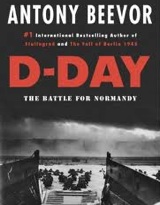D-Day: The Battle for Normandy – Book Review
 D-Day: The Battle for Normandy. Anthony Beevor. 2009. 608 Pages. Hardback. $32.95. Paperback. $18.00.
D-Day: The Battle for Normandy. Anthony Beevor. 2009. 608 Pages. Hardback. $32.95. Paperback. $18.00.
I had come to the conclusion many years ago that I would never read another book regarding D-Day. After devouring books by Paul Carrell, John Keegan, and Cornelius Ryan, I believed there was really nothing more of substance that could be written on the subject. I was doing well on my internal pledge until I discovered acclaimed military historian Anthony Beevor had crafted his own volume on D-Day. Being an ardent admirer of his previous works (Stalingrad, The Fateful Siege 1942-1943 and The Fall of Berlin 1945), the temptation was too great, and my vow was broken.
{default}Beevor concisely delivers far more than the title promises. Although he devotes significant coverage to the early weeks of June 1944, he takes readers much further. In fact, the book continues through The Liberation of Paris in late August 1944. Along the way he addresses such events as Operation Goodwood, Operation Cobra, the Mortain Counterattack, and the fighting of the Falaise Pocket.
There are two obvious questions to ask on any book released today related to D-Day. First, what value does the volume add to the existing body of knowledge? Second, how does the book add to the overall understanding of D-Day?
In regards to adding anything new to the body of knowledge, readers will not find any previously uncovered nuggets. To be truthful, I am not sure if there are any nuggets out there to be uncovered. There are not many periods in history that have been dissected and researched as much as D-Day. Thus, and not surprisingly, Beevor has not added anything of significance to the existing body of knowledge.
However, in reference to the second question, I believe the author has added considerably to our overall understanding not only of D-Day but of operations in France up to and through the liberation of Paris. Beevor achieved this primarily by his ability to look at events from various perspectives and his techniques for presenting these perspectives.
Throughout his volume, he looks at events through the perspectives that range from soldiers fighting on the ground to leaders making operational and strategic decisions. As is his practice (and unique strength) Beevor moves effortlessly from the tactical to the operational to the strategic levels of war throughout his book. In one paragraph, he may insert a first-person account—these accounts are invaluable, by the way—on a soldier’s feelings as he prepares to land on Omaha Beach. Shortly after, readers will find a discussion between Gen. Dwight Eisenhower and his staff on the initial progress of the Allied attack. This technique greatly assists readers in gaining a far better understanding of D-Day and beyond.
The author also addresses a perspective that is usually glossed over—that of the French. In the vast majority of books I have read, there is minimal or no discussion on how operations affected the French politically or the effect of those operations on the French populace. Beevor reverses this trend by devoting considerable copy to these subjects. Throughout the book, he adds numerous accounts from the French populace and highlights the interaction between Charles DeGaulle, Franklin D. Roosevelt, and Winston Churchill. This discussion is invaluable to our overall understanding of events.
Finally, Beevor has made the decision to look at D-Day (and beyond) through the eyes of both the Allies and the Germans. Consequently, readers receive a total perspective that is missing from the preponderance of books written on the subject. Attempting this technique is easier said than done. Obviously, the author ran the risk of confusing his readers. However, his outstanding organizational skills and innate ability to determine what is important for readers to know makes it work. The end result is a better comprehension of the events from D-Day through the liberation of Paris.
Those who have read previous Beevor works know there is never a shortage of analysis on decisions or individuals. Within his latest volume, readers will find that same type of examination. The author provides his thoughts on many topics (in particular on British Field Marshal Barnard Montgomery). Whether you agree or disagree with his opinions, he provides much to reflect upon.
For those like me who thought they had read their last D-Day book, I highly recommend they re-think that. I believe they will find D-Day: The Battle for Normandy unique in this genre of books and well worth their reading time. It delves into this period in ways previous books have not. After reading Beevor’s volume, I can now make a new pledge to myself. On second thought, I better not; I’m told Rick Atkinson’s book on the western front should be released in 2013!
Rick Baillergeon is a retired U.S. Army Infantry officer. Since his retirement, he has served as a faculty member at the U.S. Army Command and General Staff College. He is also co-author of the popular ACG Web series, "Tactics 101."


No more historical nuggets to be discovered? My goodness, you obviously have not read my book, “Eisenhower & Montgomery at the Falaise Gap.” There is a whole new historical world out there awating your discovery. Revisionist to be sure, but I have not had any serious factual challanges to the account.
Bill W.